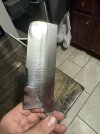- Joined
- Oct 28, 2024
- Messages
- 2
Hi, I’ve been looking up questions for a while but finally joined to ask my first question. After using two of the Red Label buffing wheels my knives always seem to be covered in grind lines. My belt process has been 36, 60, 120, 240, 320, 400, non woven belts, buffing wheels. I can’t tell if these are low grit deep lines or if I’m just not going high enough. I don’t include any hand sanding in my process currently fyi. Any help would be greatly appreciated.


Last edited:
